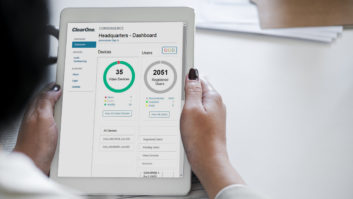Audio and video conferencing is fast becoming a business essential. Jonathan Mangnall, of AMX looks at the key things you need to think about.
As the costs associated with travel continue to rise, and the prices for technology and bandwidth continue to decline, a robust audio and video conferencing system is becoming an increasingly valuable commodity. By harnessing the very best of today’s interactive telecommunication technologies it is possible to provide your clients with a viable virtual platform on which to conduct their business, in real time.
In order to ensure that your clients can benefit from true ‘visual collaboration’ and the sort of point-to-point and multi-point telecommunications system that comes as close as possible to replicating a face-to-face meeting, it is vital that technological consideration be made at the design stage. Video conferencing, that is to say the means by which two or more locations can interact simultaneously via two-way video and audio transmissions, incorporates a range of technological elements. Amongst the necessary components are a video input, such as a webcam or video camera, and a video output in the form of a computer monitor, screen or projector. Microphones provide audio input while loudspeakers provide audio output. A digital or analogue network, or the internet, is needed for data transfer. A virtual conference may use telephones, screens, computers, conferencing software, collaborative software, file sharing, headsets, or any combination of these. Slide presentation, audio-streaming, and document sharing are just some of the extras that can be incorporated into this conferencing method.
Successful video conferencing relies on each connected component being properly installed and well adjusted. Poor positioning of the video camera, for example, can result in hazy or distorted images while poor microphone and speaker connections can cause voices to be inaudible. In an ideal world, the camera should be positioned at eye-level and as close to the screen as possible while an array of multiple microphones will facilitate even sound capture. Remember that ceiling-mounted microphones reduce background noise and interference much more efficiently than table mounted mics. Think about specifying multiple screens as opposed to one huge screen. This breaks images down for more manageable data transfer and provides better content distribution, such as displaying PowerPoint files or photos on individual screens.@page_break@
However sophisticated a system, careful consideration needs to be given to the room design itself; diffused fluorescent lighting is the best for video conference rooms, even if you’re just allowing for occasional Skype, FaceTime or GoToMeeting calls, and the room should be kept evenly lit in order to minimise shadows. Pay attention to sight-lines, as many modern telepresence and VC systems incorporate cameras that ‘follow’ the speaker – panning to focus on the next presenter or contributor. In some cases, when multiple locations participate at the same time, having screens on the long side of the room works best.
The overall VC quality of service is important, high definition calls should not be run over ADSL as the upload speed is often a limiting factor. Where possible, consider running VC over a separate VLAN. A Firewall configuration should be considered for security and multiple-site VC systems should have a network “bridge” to improve security and reduce network overheads.
With so many operating platforms, audio and video conference rooms are complex places. As more and more technology is introduced, the opportunities for system conflicts, user confusion and mismanagement grow accordingly, and the level of complexity involved in using the system increases.@page_break@
To get the most value from these systems, a comprehensive, easy to understand and user-friendly control and management system is essential. Unified solutions automate and control all the electronics and content needed for world-class corporate communication. From audio-visual equipment, media-driven presentation facilities and conferencing, right down to the in-room environment itself; innovative technology will ensure that your client’s telecommunications set-up is centrally managed and easily controlled, all at the touch of a button.
Don’t forget that, in order for people to use it (and for companies to take advantage of the savings and other benefits) they need to be confident they can easily make it all work – even when they are stressed ahead of an important presentation. A control system, with preconfigured calls and settings, makes all the difference.
With a unified approach, an unprecedented level of management capability can be realised. Administrators can be given precise control over the various layers of the system, including resource allocation, signal management and routing; whilst participants enjoy a greatly simplified user experience, with a single interface to replace the plethora of often complicated VC and AV remotes.@page_break@
Touchpanels provide fingertip control of conferencing facilities and maximise the communication experience. They can be optimised for ease of use with presets that trigger a series of orchestrated events. At the press of a button, the VC system and screens can be automatically switched on, the lights lowered to a pre-determined level and the audio adjusted accordingly; ensuring that those wanting to use this platform can do so easily and efficiently.
After all, we all need reliable, clear, up-to-date communications to make the most of the working day. The latest generation of AMX-controlled, network and communications systems ensures that everyone can benefit from your client’s technological investment by participating in the kind of live, visual interaction that increases business efficiency and removes the traditional restrictions of distance and time.
Jonathan Mangnall is sales director at AMX






